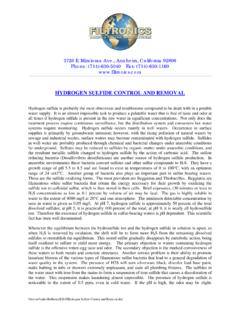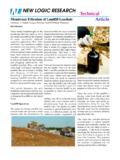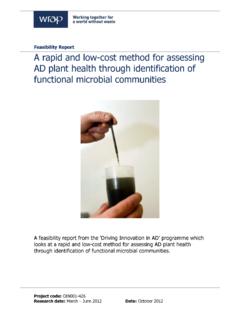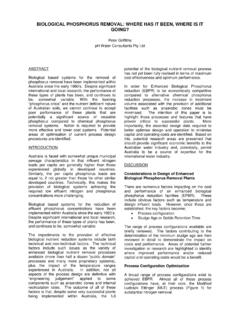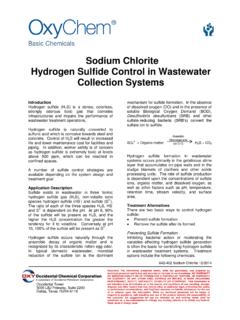Transcription of IRON AND MANGANESE FILTRATION SYSTEMS - …
1 Copyright Notice Copyright 1993 -2011 by Filtronics, Incorporated. All rights reserved. Trademarks Electromedia is a registered trademark of Filtronics, Incorporated. Electromedia I is a trademark of Filtronics, Incorporated 3726 E. Miraloma Ave., Anaheim, CA 92804 Phone: (714) 630-5040 Fax: (714) 630-1160 iron AND MANGANESE FILTRATION SYSTEMS A TECHNICAL DISCUSSION INTRODUCTION iron (Fe) and MANGANESE (Mn) are elements that are commonly found in the earth as insoluble forms of ferric oxide and MANGANESE dioxide. iron and MANGANESE do not dissolve in water that contains oxygen. They do become soluble when water that has no dissolved oxygen percolates through geological formations containing ferric oxides and MANGANESE oxide, MANGANESE carbonate and carbonates.
2 The occurrence of iron and MANGANESE is commonly found in well water and impounded surface water supplies where anaerobic conditions exist. Biological activity can be a strong factor in dissolving iron and MANGANESE by producing carbon dioxide and lowering the pH. iron and MANGANESE are reduced to their lower valence states of +2 and form soluble bicarbonates. It is not unusual to find high concentrations of carbon dioxide along with iron and MANGANESE in groundwater supplies. Therefore, in the treatment of iron and MANGANESE the corrosiveness (Langelier Index) should be investigated to assure the treated water will not be aggressive and corrode system and customer piping. iron in water supplies usually exists in either of the following oxidation states: a) Divalent Ferrous iron (Fe+2) which is the soluble form of iron found in water supplies.
3 B) Trivalent Ferric iron (Fe+3) which is a stable form of iron that is typically insoluble in water. (See Figure 1). MANGANESE usually exists in water supplies in the following oxidation states: a) In any oxidation state from Mn0 to Mn+4. b) Soluble manganous oxide, Mn+2. c) Manganic oxide, Mn+4, the stable form of MANGANESE that is insoluble in drinking water supplies. When iron and MANGANESE are found in water that has no dissolved oxygen they exist in the reduced soluble forms. These soluble forms are: divalent ferrous iron , (Fe+2) and manganous oxide, (Mn+2). Dissolved iron and MANGANESE are removed from water supplies predominately by oxidation and FILTRATION . The soluble ferrous and manganous forms are oxidized to the insoluble ferric and manganic forms.
4 The insoluble ferric and manganic precipitates are then filtered. COMMON EFFECTS Soluble iron and MANGANESE cause the following objectionable problems in drinking water supplies. The EPA has established secondary standards of mg/l for iron and mg/l for MANGANESE to alleviate these objectionable affects to water consumers and purveyors. WATER CONSUMER Metallic and bitter taste and odors. Staining of porcelain household fixtures, clothing and swimming pool plaster. iron causes a reddish color. MANGANESE causes a blackish color. iron and MANGANESE in combination cause reddish black color. Fouling of water softener resins. Water quality decreases and regeneration costs are significantly increased Fouling of cooling water SYSTEMS .
5 Deposition in water heaters. Industrial process water contamination such as food, beverage and textile processing and silicon chip manufacturing. WATER PURVEYOR Deposits in pipelines, service laterals and reservoirs. Clogging of water meters. Constant water main flushing required. Reduction in pipe diameter resulting in higher energy costs. Varying water velocities and direction can cause high concentrations of iron and MANGANESE to break free from the pipe. Responding to numerous consumer complaints regarding tastes, odor and color. Ferrous iron provides a food supply for the growth of bacteria in the distribution system . FACTORS AFFECTING iron AND MANGANESE REMOVAL The removal of iron and MANGANESE from potable water supplies is affected by various chemical and physical characteristics of the water.
6 These characteristics are interrelated and an accurate and complete water analysis is essential to identifying potential problems. Proper design of the required pretreatment and FILTRATION SYSTEMS depend on a complete and accurate water analysis. Those factors are: TIME The reactions are not instantaneous. Detention time following oxidation will determine the completeness of the chemical reactions. Five to twenty minutes may be required for the oxidation and precipitation of iron . Up to two hours may be required for the oxidation and precipitation of MANGANESE . pH The oxidation rates are slower at low pH values than at high pH values. Oxidation by aeration requires a pH greater than for iron and greater than for MANGANESE .
7 TEMPERATURE The oxidation rate is faster at higher water temperatures than at lower water temperature. The rate of reaction doubles for every 10 C increase in temperature. TOC The oxidation of iron and MANGANESE is slower in the presence of organic matter that forms complexes. Chelation can occur which severely inhibits the oxidation of iron and MANGANESE . DISSOLVED OXYGEN The presence of dissolved oxygen accelerates the oxidation of iron and MANGANESE . AMMONIA Ammonia exerts a significant oxidant demand and interferes with the oxidation of iron and MANGANESE . CARBON DIOXIDE Carbon dioxide lowers the pH of the water through the formation of carbonic acid and reduces the rate of oxidation. LANGELIER INDEX Corrosive water with a negative Langelier Index dissolves iron and MANGANESE in proportion to their solubility product at the observed pH.
8 It also constitutes the reason for many red water complaints when the raw water iron and MANGANESE values may even be at or below MCL levels. The treatment for corrosive water should be addressed as a pre-treatment requisite for iron and MANGANESE . HYDROGEN SULFIDE (H2S) This gas is often found in groundwater that contains iron and MANGANESE . It is easily identified by its "rotten egg" odor. In addition to causing serious taste and odor problems, sulfide also promotes the growth of sulfur bacteria. Hydrogen sulfide can cause corrosion problems with iron and concrete pipes and reservoirs. Sulfides are formed by the anaerobic reduction of sulfates and organic matter into sulfides and bisulfides. This reaction is pH dependent. Hydrogen sulfide predominates at a pH of less than 7.
9 Hydrogen bisulfide predominates in a pH range between 7 and Sulfide is predominant at a pH above Standard treatment for hydrogen sulfide has been aeration and degasification or oxidation with chlorine to elemental sulfur. Hydrogen sulfide reacts with oxidants such as Cl2, O3 ClO2 and H202 to form polysulfides (HSm) and hydrogen polysulfide (H2Sm). These compounds cause a milky blue suspension of colloidal sulfur getting a "musty or earthy" taste or an odor similar to a rubber tire and a taste similar to drinking from a rubber garden hose. This odor may not become apparent until the water is heated and the polysulfide odor is released. Polysulfides are treated by oxidation and the addition of sulfur dioxide (SO2).
10 The sulfur dioxide promotes the conversion of polysulfides and elemental sulfur to thiosulfate. Oxidation of sulfides in the treatment process is extremely important in the removal of iron and MANGANESE . The following factors affect water quality: Treatment of all other substances that have an oxidation demand must be completed before the oxidant can effectively oxidize iron and MANGANESE . Organic complexes must be oxidized before the oxidant can effectively oxidize iron and MANGANESE . An excess of mg/l of oxidant (chlorine) is required in this reservoir/distribution system to inhibit any growth of sulfur bacteria. Sulfide oxidation must be complete or taste and odor problems will persist in the distribution system even though iron and MANGANESE has been removed.
